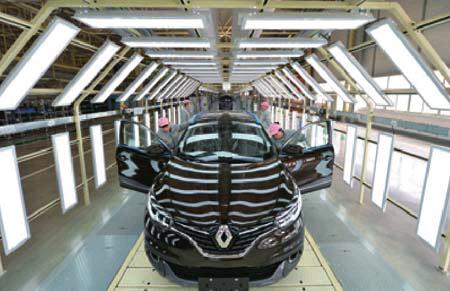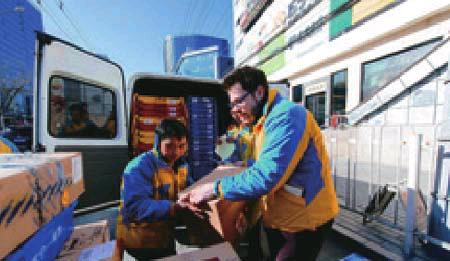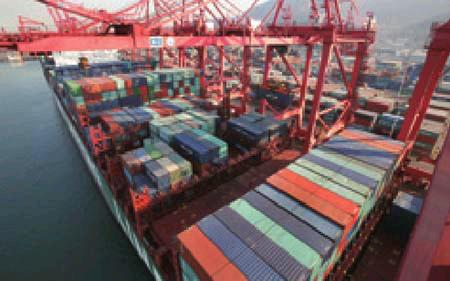Celebrating Spring Festival
2016-02-23
People visit a Spring Festival temple fair at Longtan Park in Beijing on February 11. The Spring Festival, or the Chinese Lunar New Year, fell on February 8 this year.
The temple fair, originated in ancient times, is usually held in the open or near a temple for participants to buy products and watch entertainment performances.

Military Reform
China regrouped its seven military area commands into five new battle zones—the eastern, western, southern, northern and central theater commands—in its push to reform the Peoples Liberation Army (PLA) on February 1.
Chinese President Xi Jinping conferred military flags to the five newly established theater commands at a ceremony.
“The move to establish the theater commands and form the joint battle command system is a strategic decision by the Communist Party of China (CPC) Central Committee and the Central Military Commission (CMC) to build a strong military. It is also a landmark step in implementing the military reforms and building the PLAs joint battle system,” Xi said.
Chinas military reform is aimed at establishing a three-tier command system, the “CMC—theater commands—troops,” and an administration system that goes from the CMC through various services to the troops.
Before the reshuffle, China had seven military area commands headquartered in Shenyang, Beijing, Jinan, Nanjing, Guangzhou, Chengdu and Lanzhou.
HK Riot
Some 300 rioters clashed with Hong Kongs police force following a clearance operation on illegal hawkers from late February 8 to the morning of February 9. At least 61 rioters were arrested and nearly 90 police officers injured.
The disturbance erupted after a handful of illegal street vendors refused to halt their business in Mong Kok, a busy commercial district, and confronted the law enforcement officials. Rioters then arrived and encountered police reinforcements.
The agitators attacked the police with bricks, stones and other makeshift weapons. The police were forced to fire two warning shots in a bid to rescue personnel.
Lo Wai-chung, Hong Kongs Commissioner of Police, told a press conference on February 9 that the police could not rule out the possibility that it was a prepared and organized riot. Investigations are underway, he said.
Hong Kong Chief Executive Leung Chun-ying condemned the rioters violent behavior and expressed his support for the police and their efforts to restore order.
Population Control
Beijing vowed to reduce the permanent population in its six downtown districts by 3 percent from the previous year in 2016, local authorities said on February 2.
Data from the Beijing Statistics Bureau showed that the six downtown districts, namely Dongcheng, Xicheng, Chaoyang, Haidian, Fengtai and Shijingshan, had a permanent population of around 12.9 million by the end of 2015.
Lu Yan, Director of the Beijing Municipal Development and Reform Commission, the economic planning body, said that the permanent population growth in downtown areas should dip into negative territory this year as the city continues to move out “noncapital functions.”
The permanent population—defined as people who have lived in the city for six months or more—of Beijing was 21.7 million by the end of 2015, close to the entire population of Australia.
The overpopulated city has sought to address “urban diseases”such as traffic congestion and air pollution by easing the demographic pressure on downtown regions and transferring some universities, hospitals, companies and wholesale markets to suburban areas or nearby cities.
In the next five years, the permanent population in the downtown areas will drop by a further 15 percent from 2014 figures, authorities said.
Passenger Blacklist
Passengers who threaten or assault airport staff and cabin crew will be blacklisted, according to an industry regulation, which took effect on February 1.
The regulation issued by the China Air Transport Association lists 10 forms of misconduct such as blocking and attacking check-in counters, security check passages and boarding gates.
They also include fighting inside the airport or on board the aircraft, attempts to force entry into the cockpit or to open the emergency exits without instruction as well as the spreading of false information about terrorist attacks.
The association will record the offending passengers personal information and share it with other airline companies and the TravelSky Holding Co., a stateowned service provider of aviation information that operates Chinas national electronic travel distribution system.
The record will be kept for one to two years, according to the rules. Passengers who disagree with their treatment can appeal to the association.
4G Users
China saw 289 million new users join its 4G network in 2015, bringing the total to 386 million, according to the Ministry of Industry and Information Technology (MIIT).
Since the “Broadband China”strategy was floated in August 2013 by the State Council to get more people online, the broadband network has developed significantly.
China aims to make 4G available across the whole country by 2018, according to an action plan published by the MIIT in December 2015. The country now has 785 million mobile broadband users.
Long Rescue
Four miners were rescued on January 29 after being trapped underground for 36 days due to a gypsum mine accident in Pingyi County, Shandong Province.
To extract the workers, the rescue team drilled two access shafts, one as a backup, using a large-diameter drill head. This is the first time that such a rescue process has been applied in China, and is the third time the technology has been used worldwide.
Tibets Healthcare
Southwest Chinas Tibet Autonomous Region is determined to expand medical services to its 1,700 monasteries, benefiting over 46,000 monks and nuns over the next five years.
The regional commission of health and family planning said at the annual meeting of the regional legislature, which opened on January 27, that health care clinics will be set up in monasteries across the region while monks and nuns with medical skills will also be sent there.
The region launched the project to construct clinics in monasteries and train monks and nuns medical skills at the beginning of 2015.
Monks and nuns are encouraged to study medicine in Tibet. The commission has ordered hospitals, medical schools and institutions across the region to offer free basic medical training to all monks and nuns.
The regional government has also earmarked 13 million yuan($1.97 million) annually since 2011 to ensure all monks and nuns are included in the basic medical insurance system.
Baby Panda Training
Staff members dress up in panda costumes conduct physical examination on baby giant panda Xinnier at Hetaoping field training base in Wolong, a major giant panda habitat in southwest Chinas Sichuan Province on January 27.
Three panda babies that were born in 2015 took part in a field training exercise recently.

Cancer Death
Cancer may have caused some 2.8 million deaths in China in 2015, which means more than 7,500 people die of cancer every day, according to a study by Chinese scholars.
“With increasing rates of incidence and mortality, cancer is a leading cause of death in China and is a major public health problem,”said the study published by the U.S. medical journal CA: A Cancer Journal for Clinicians.
It also estimated that nearly 4.3 million were diagnosed in 2015, with 12,000 daily new cases.
The figures marked a sharp rise in new diagnoses. Figures released in 2013 estimated that there were 3.12 million new diagnoses and over 2 million deaths in 2012.
The figures in the study are not actual numbers, but are estimates based on data trends from 72 local, population-based cancer registries between 2009 and 2011.
It said lung, stomach, esophageal, liver and colorectal cancers were the most common types of cancer in men, accounting for about two thirds of all cases.
QFII Rules Loosened
China has further loosened controls over the investment of Qualified Foreign Institutional Investors (QFII) to increase the opening up of the domestic capital market.
China relaxed investment quotas for single institutions under QFII programs and allowed for more convenient capital flows, according to a new policy released by the State Administration of Foreign Exchange(SAFE). The rules became effective on February 3.
The move aims to improve the convertibility of Chinas currency, the yuan, in the capital account and facilitate cross-border investment and financing, the SAFE said.
The yuan is convertible for trade purposes under the current account, while the capital account, which covers portfolio investment and borrowing, is still largely controlled by the state over concerns of abrupt capital flows in and out of the country.
To gradually open the capital account, the government introduced the QFII and RMB-denominated Qualified Foreign Institutional Investors (RQFII) programs in 2003 and 2011 respectively.
Declining PMI
Chinas manufacturing activity contracted for a sixth month straight in January, pointing to persistent weakness in the sector, data showed on February 1.
The purchasing managersindex (PMI) came in at 49.4, down from Decembers 49.7, according to data released by the National Bureau of Statistics (NBS) and the China Federation of Logistics and Purchasing.
A reading above 50 indicates expansion, while a reading below 50 reflects contraction.
NBS statistician Zhao Qinghe attributed the retreat to slowing factory activity ahead of the Spring Festival holiday (February 7-13), as well as Chinas ongoing campaign to resolve excessive capacity.
The economic slowdown both at home and abroad also affected aggregate demand and foreign trade growth, Zhao explained.
In addition, Chinas service sector activity also slackened in January, according to NBS data. The PMI for the nonmanufacturing sector came in at 53.5 in January, down from 54.4 in December, but was still above the 50-point demarcation line.
Brand New Line
Workers check unfinished cars at the assembly line in the factory of Dongfeng Renault Automotive Co. Ltd. based in Wuhan, capital of central Chinas Hubei Province.
French automaker Renault opened its first factory in China on February 1, in a joint venture with Dongfeng Motor Corp. that has an initial annual production capacity of 150,000 cars.

Less Down Payment
China announced on February 2 that it would lower the minimum deposit required for home purchases in most cities, to spur the real estate market.
The Peoples Bank of China(PBOC), the central bank, said that in cities where there was no home purchasing restrictions, down payments for first homes financed by loans from commercial banks will stay at a minimum of 25 percent “in principle,” but they can go down as much as an additional 5 percentage points.
For those who want to buy a second home with commercial loans but have outstanding loans on their first property, the down payment requirement will be cut to no less than 30 percent from the current 40 percent.
The PBOC said that those citieslocal governments can decide on the exact deposit requirement according to their own conditions, under the guidance of the PBOC and the China Banking Regulatory Commission.
In cities where home purchasing restrictions still apply, old down payment rules will remain effective, the PBOC said.
Beijing, Shanghai, Guangzhou and Shenzhen in Guangdong Province, and Sanya in Hainan Province are the five remaining cities with restrictions on home purchases, which were introduced in 2010 to rein in house prices.
Rare Earth Restructuring
China, the worlds largest producer and exporter of rare earth elements, will complete a major restructuring move by mid-2016 to consolidate the industry.
The work on forming mining blocs for the rare minerals will be finished by the end of June to restructure the countrys rareearth assets, said Xin Guobin, Vice Minister of Industry and Information Technology, at a symposium.
Chinas rare earth industry is beset by problems including illegal mining, smuggling and a lack of competitiveness due to weak research and development.
In a bid to consolidate and upgrade the industry, the government pledged in 2014 to encourage and support six industry leaders to carry out mergers and acquisitions separately to create large rare-earth producers.
Three firms have already formed rare-earth blocs separately and the other three are still working on it.
Xin said that this year will see a reduction of rare-earth smelting capacity, improved output control and increased competitiveness.
By the end of 2020, China should have enhanced its protection of rare earth resources and have world-leading rare earth-related technology, Xin said.
Rare earth metals are vital for the manufacturing of hi-tech products ranging from smartphones and wind turbines to car batteries and missiles.
Foreign Deliveryman
He Wenxu, a British man working for a magazine and known by his Chinese name, delivers express packages as a part-time courier in Beijing on February 1. Around the Chinese Lunar New Year (Spring Festival) on February 8, electronics retailer Suning E-commerce recruited foreigners into its team of deliverymen.

New Sea Route
A new shipping route linking the Port of Qinzhou in the Beibu Gulf—in south Chinas Guangxi Zhuang Autonomous Region—with Iran has been launched, sources with the Guangxi Beibu Gulf International Port Group said February 1.
The Iranian container ship Perarin, which can carry 3,280 standard containers, arrived at the Port of Qinzhou on January 27 to deliver 978 containers from several countries along the 21st-Century Maritime Silk Road.
The arrival of the Perarin at the port marked the opening of the first shipping route linking the Middle East to the Beibu Gulf which comprises three ports in Guangxi—Qinzhou, Beihai and Fangchenggang.
The international shipping line connects some ports in south and southeast China to those in Singapore, Malaysia and the United Arab Emirates, before ending in the southern Iranian port of Bandar Abbas, according to the sources.
There are 22 ships departing from the Beibu Gulf each week for major ports in Southeast Asia. Guangxi is now looking to extend its shipping routes to more Middle East and European countries to boost foreign trade.
Drone Export
The export volume of civilian drones in south Chinas Shenzhen, Guangdong Province, increased seven times in 2015 year on year to reach 3.09 billion yuan ($472 million), customs data showed.
The citys civilian drones were mainly exported to Hong Kong, North America and Europe, according to Shenzhen Customs.
The monthly export jumped from 130 million yuan ($19.76 million) in January to 450 million yuan ($68.4 million) in December.
Shenzhen produces 99 percent of Chinas civilian drones for export. The drone industry is one of the citys priority sectors.
Shenzhen-based DJI, a leading manufacturer of commercial and recreational drones for aerial photography and videography, holds almost 70 percent of the market share worldwide, with Europe and North America as its largest customers.
A High Score
Ships unload containers at the port of Lianyungang, Jiangsu Province, on February 2.
In January, cargo throughput at the port of Lianyungang reached 19.06 million tons, up 1.58 percent year on year.

Art Trade
A newly revised regulation on art dealing, issued by the Ministry of Culture on February 2, has eased restrictions on the import and export of works of art.
The ministry has delegated the management of the cross-border art trade to provincial governments.
Dealers now only need to obtain a standard business license. They must register with the cultural department, but no longer need to meet any extra departmental requirements.
